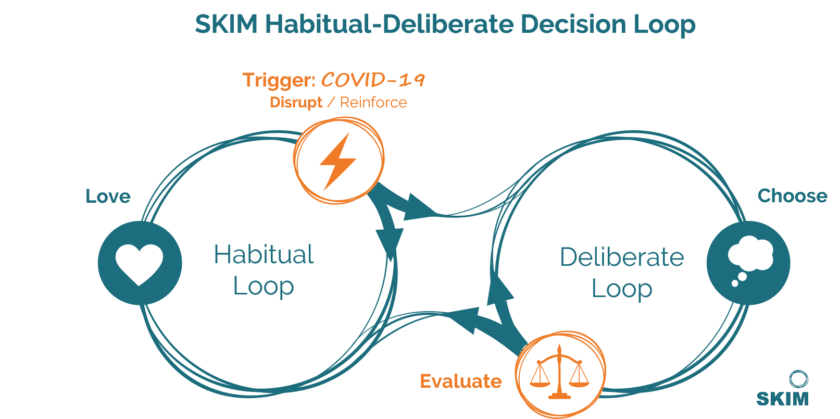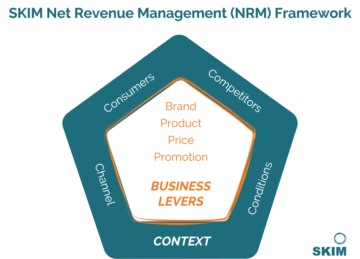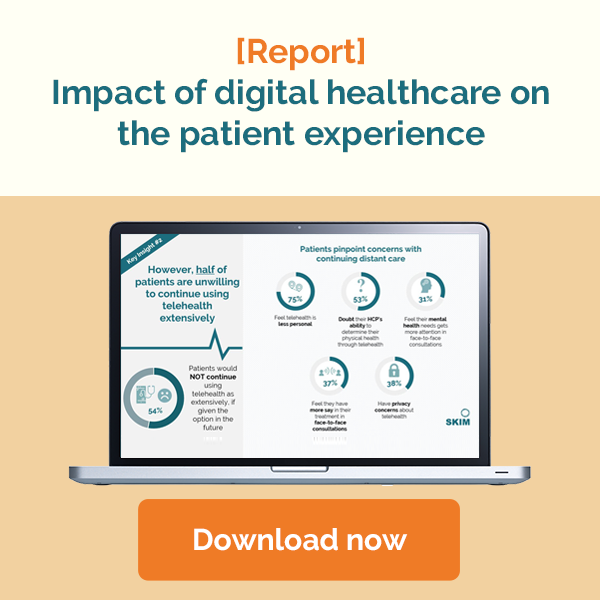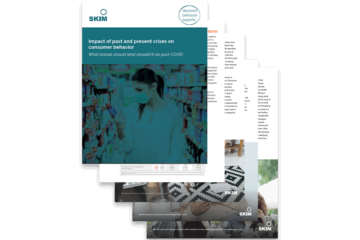Contents
Decision behavior amidst disruption
Adapting your marketing mix for short and long-term success
Exploring psychological distance, social distancing and decision making
Consumer goods: Adapting pricing and NRM strategies
Pitfalls brands should avoid post-crisis
Consumer goods: Optimizing eCommerce strategies post disruption
Healthcare: Accelerating digital pharma marketing strategies now
Decision behavior amidst disruption
From consumer goods to the healthcare industry, COVID-19 changed decision behavior. Stay-at-home guidelines and stock shortages accelerated online behavior and trials of new product choices by consumers. Pharma companies were also forced to accelerate their digitalization strategies and shift HCP marketing to online. Across industries, the question remains – which behavioral shifts will last?

As marketers, you need to quickly adapt to consumers’ short-term needs, while also keeping an eye on shoring up your long-term strategies.
To make the right decisions, it’s vital to understand the fundamentals of decision behavior.
The SKIM Habitual-Deliberate Decision Loop provides a framework for companies to understand decision behavior and help guide their business strategies – to achieve both short- and long-term goals.
It is especially useful to understand how COVID-19 dramatically changed the context of decision making. For consumers, the global crisis triggered a disruption, moving their “habitual” purchase decisions to more “deliberate” shopping behavior. With over 40 years of expertise analyzing consumer behavior, we’re here to help with tips and best practices.
Adapting your marketing mix for short and long-term success
You know you need to adapt your marketing mix as you react to unprecedented events. To thrive in both the short and long term, it’s important to adapt your “4Ps” (product, place, promotions, and price) in the context of decision behavior.
The 4Ps are the factors you can control, despite uncertain times. Ensuring your strategy for each one is rooted in behavioral frameworks will give you the competitive edge. Read on for practical considerations to keep in mind when using the traditional 4Ps.
How to be relevant during COVID-19 crisis

With so much uncertainty about which new “habits” will stick on the other side of the crisis, there are ways to deliver real value now, in the short term.
You will need to base these on your consumers’ needs and priorities now, but what are they?
A deeper dive into consumer behavior and decision-making reveals three critical needs.
1) protection 2) connection 3) entertainment
These three are shaping how consumers react now. How is your company addressing these?
Find out how brands like UberEats, Microsoft, and L’Oreal are using their 4Ps to meet these shifting priorities, and check out our practical brand strategy tips you can put into action now.
Preparing for success in recovery phase

As a new economic reality sets in, how will you adapt your marketing mix? For each of the 4Ps, there are vital questions to consider when heading into the recovery phase, such as:
Product: Which features and benefits will be more valuable to consumers?
Place: Which online triggers and touchpoints will have more influence?
Pricing: How should you optimize your assortment and pricing strategy?
Promotion: What messaging will deliver the most impactful content to boost awareness, engagement and conversion – online and in-store?
Understanding decision behavior is key to learning how to influence consumers along their decision loops. Learn more about how brands can turn major disruption from challenges like COVID-19 into opportunities in the long-term.
Exploring psychological distance, social distancing and decision
Social distancing had an immediate impact on marketing across industries. You likely already adjusted your short-term communication strategy, but how should you react in the longer-term?
SKIM’s Psychological Distance Theory helps explain how the way in which a situation (or product or service) is perceived will affect the reaction to it. It argues that the greater the psychological distance from it, the less likely people are to alter their behavior.
 A look at how psychological distance played out in the early stages of the pandemic delivers valuable decision-making insights. In particular, it helps explain the different reactions in Asian and Western countries.
A look at how psychological distance played out in the early stages of the pandemic delivers valuable decision-making insights. In particular, it helps explain the different reactions in Asian and Western countries.
The theory can also be used as a tangible way to improve communications for your brand or organization. As the new normal evolves, how do you adjust your communications to reflect consumers’ new desires? And how could you communicate broad-reaching issues (e.g. sustainability) more effectively? Understanding psychological distance in today’s context can also help us better understand human decision-making.
Find out what we can learn by exploring psychological distance in the context of social distancing
Adapting pricing and NRM strategies
As revenue is generated by consumers, it’s heavily dependent on the situation they are in. This means that the context for pricing and net revenue management (NRM) has also been disrupted.
 To succeed in your revenue management strategies, you need to use your business levers (product, brand, price and promotion), and consider the external context. This includes anticipating and influencing consumer decisions following the Corona crash. What economic and commercial factors will influence them? How sensitive will consumers be to change and will they still be willing to pay for your product?
To succeed in your revenue management strategies, you need to use your business levers (product, brand, price and promotion), and consider the external context. This includes anticipating and influencing consumer decisions following the Corona crash. What economic and commercial factors will influence them? How sensitive will consumers be to change and will they still be willing to pay for your product?
There are learnings to be gained from previous crises and from consumer behavioral frameworks. However, you also need robust consumer insights to help you understand the consequences for your revenue potential, answering questions like:
- Should you drop your prices?
- Is now the time for aggressive price promotions?
- How can you protect your long-term revenue potential, while adapting to changing, short-term priorities?
Considering pricing research amidst disruption?

With many of the behavioral shifts taking place, you may be wondering the impact on price sensitivity. Consumer consumption and their “willingness to pay” for certain products and services can change from one day to the next depending on lockdown restrictions, travel bans, news, and economic conditions.
In the “Impact of COVID-19 on consumer price sensitivity” we explored if and how price elasticities changed before and during the crisis. We re-ran 8 large pricing re-run studies in April across CPG categories in the US and Europe. The results may surprise you.
If you’re considering conducting pricing or portfolio research during the crisis, it’s important to consider the power of data and hard facts. Especially as you prepare for tough retailer negotiations during the recession.
Get our 3 recommendations for how you can tackle pricing decisions now.
Tips for pricing success post disruption
In this Quirk’s webinar we delve further into whether now is the right time to do pricing research. Here are our recommendations regarding price sensitivity, pricing and revenue management post disruption.
Watch the webinar to explore:
- What has changed and what has stayed the same for price sensitivity, brand loyalty, and package size and related buying patterns?
- How are consumer perceptions changing and by how much? What are their current value drivers and decision-making logic?
- Strategies you can use to adapt your pricing and revenue management for the current economic slow-down.
Pitfalls brands should avoid post-crisis
 When studying past crises we see how decision behavior changed during and in the wake of global events, such as 9/11, SARS epidemic etc. Reflecting on how brands and consumers responded can offer many lessons learned – what brands should and should not do.
When studying past crises we see how decision behavior changed during and in the wake of global events, such as 9/11, SARS epidemic etc. Reflecting on how brands and consumers responded can offer many lessons learned – what brands should and should not do.
How are you shifting your innovation strategies? What price cuts are you suggesting?
Brands should avoid these 3 pitfalls during the recession post-COVID.
Optimizing eCommerce strategies post disruption

With their usual shopping habits disrupted, your consumers have been pushed to try something different in implicit or explicit “forced” trials. This includes the rapid acceleration of online shopping ranging from Amazon to local grocery stores, click & collect, subscription services, and food delivery apps.
It also means shoppers who normally choose your brand may be forced to try other brands online.
In this context, how should you optimize your online strategy to keep, or win back, customers? Consider these three strategies to help you succeed:
- Optimizing for omnichannel search and purchase
- Creating digital content that drives conversion
- Optimizing your online assortment and pricing
From rethinking consumer journeys to the role of product promos and optimizing digital content, we’re sharing tips to get your online offering to the best place possible. Please  to learn more about three proven strategies for eCommerce engagement and conversion.
to learn more about three proven strategies for eCommerce engagement and conversion.
What online service providers need to know about shifting value perceptions
We’ve all noticed the boom for online service providers. Consumers have either increased consumption or been forced to try services like media streaming, online subscriptions and food delivery apps.
It’s hard to tell which new habits will stick when normalcy returns or in the case of a recession. Which services will consumers continue to subscribe to, and which will be abandoned?
Understanding how consumers value your service now, as well as how that perception may have shifted, is key to ensuring customer retention. However, your business can adapt to build customer loyalty and decrease churn.
Accelerating digital pharma marketing strategies now
 As pharma companies race to accelerate their online sales and marketing, you need to revise and reshape your multichannel strategy to meet HCPs’ behavioral shifts.
As pharma companies race to accelerate their online sales and marketing, you need to revise and reshape your multichannel strategy to meet HCPs’ behavioral shifts.
The digitalization of pharma was already underway pre-COVID. Now, there’s a new urgency to make this shift. Face-to-face sales calls are a no-go, while HCPs’ practice behavior, decision-making, and prescribing habits have all been disrupted.
How can you achieve a successful switch to a digital-first communications strategy?
Get three practical tips to start building an effective, multichannel pharma marketing strategy





